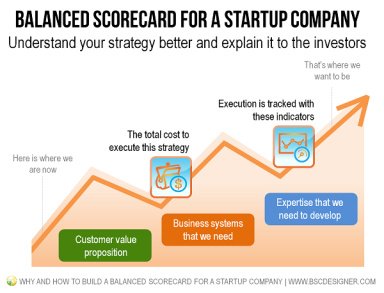
Publication number: ELQ-28783-1
View all versions & Certificate

How to Build a Balanced Scorecard for a Startup Company
Learn how to build a BSC for a startup company in a clear and concise way, written by expert Aleksey Savkin.
Introduction
Starting a business and finding investments is much easier when one has a well-defined customer value proposition. Founders of the company need to be sure about their business model, expected financial outcomes, and how exactly a company is going to spend its venture capital. While this sounds logical, startup companies tend to focus on their product too much and forget about customer needs and financial results.
On the one hand, the challenges mentioned above can be addressed by the Balanced Scorecard, and on the other hand, startups normally have a lot of other things to do, and they don’t have time for “paperwork” like, for example, formalizing their business goals on a strategy map. Still, the Balanced Scorecard exercise is very useful for a startup company. Let’s discuss how exactly it can help.
Why does a startup need a Balanced Scorecard?
It makes sense discussing two arguments.
Argument 1. Getting a clear understanding of the strategy.
Balanced Scorecard with a strategy map and aligned KPIs is a great way to get a crystal clear understanding about:
> The expected financial results,
> Customer value proposition,
> Business processes that a company needs to have, and
> Key learning and growth direction to focus on.
Argument 2. “Selling” the idea to the investors.
Ultimately the investors want to know:
> How and when they will get their money back in a form of profit or after attracting even larger investments;
> What customer’s problem you are going to solve, and if your business model and team are ready to solve it.
Both arguments are important, but when explaining the idea of a Balanced Scorecard to the startup founders I found the second argument much more convincing. For sure, it is possible to present all the same information on several PowerPoint slides, but the trick is that investors came from the corporate world where they have some standards for presentation of the information and the Balanced Scorecard is becoming one of those standards. This idea is actually very similar to why non-profit organizations need to have BSC.
- Step n°1 |
Prepare strategy map that shows how customer value is created
We have some step-by-step guides on building and implementing Balanced Scorecard [www.bscdesigner.com](as well as an Online Training where you will build a prototype of your own business scorecard), so now I’ll focus only on the nuances that I believe are important for a startup company.
1. Financial perspective. If you call your company a startup then you want to underline that it was recently started, and/or that you are looking for investments. If second is the case, express clearly what financial outcomes you plan to achieve, when you plan to achieve them, and when your company will became cash-positive. More about financial perspective…
2. Customer perspective.The idea is to explain here is the customer value proposition. What is typically overlooked is that under the “customer” perspective we also need to add partners. What kind of partners do you need? What kind of support from your side do they need in order to work effectively and efficiently? More about customer perspective…
3. Internal business processes.Tell here about key business systems that you need. What is also important is to show (by cause-and-effect links) how these business systems will help you to deliver promised customer values. More about internal perspective…
4. Learning and growth. A general idea of this perspective is to show where you need to focus your learning efforts in order to create the best value for your customers. In a case you are looking for investments, you normally don’t just look for money, but also for an expertise in a certain area. Map your learning priorities using this perspective.
add_shopping_cartContinue reading for free (70% left)

